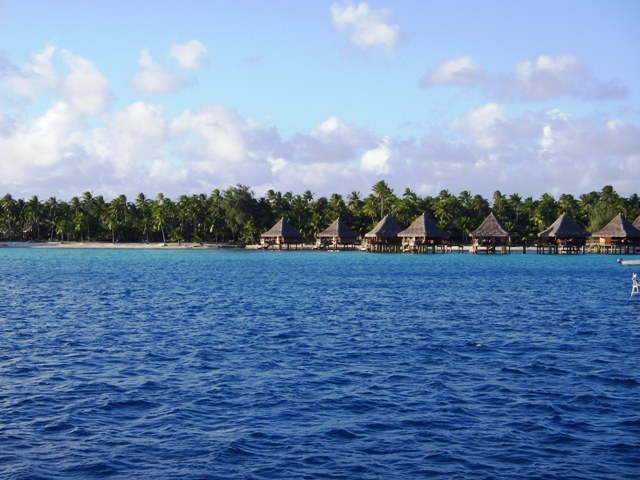
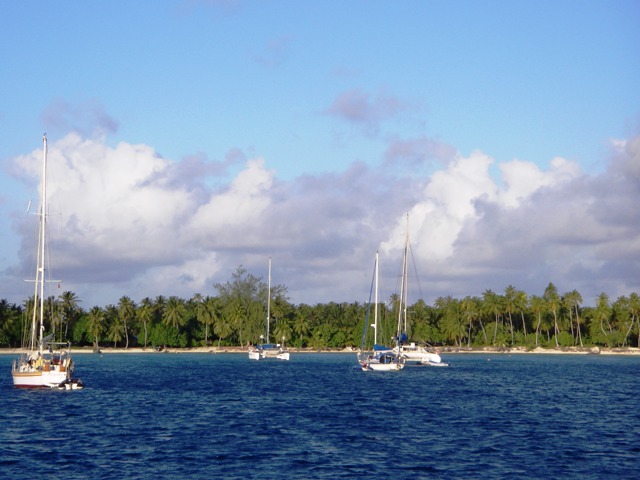
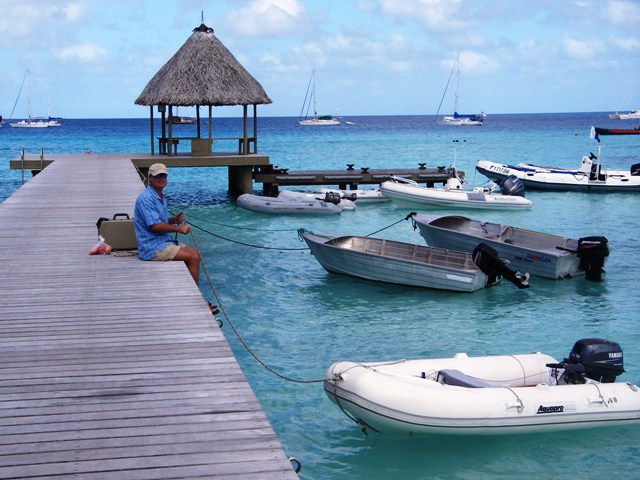
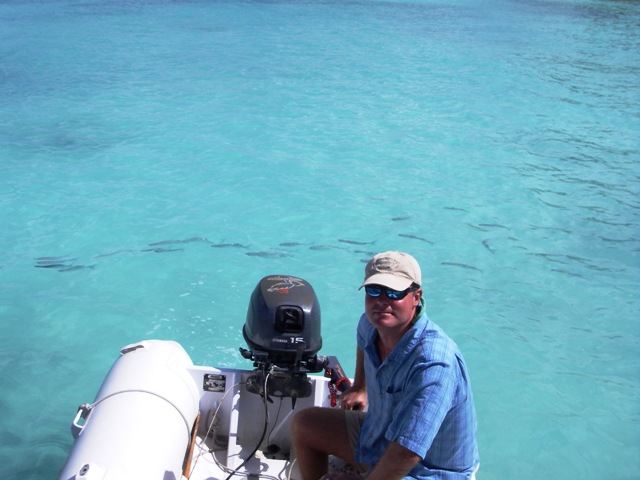
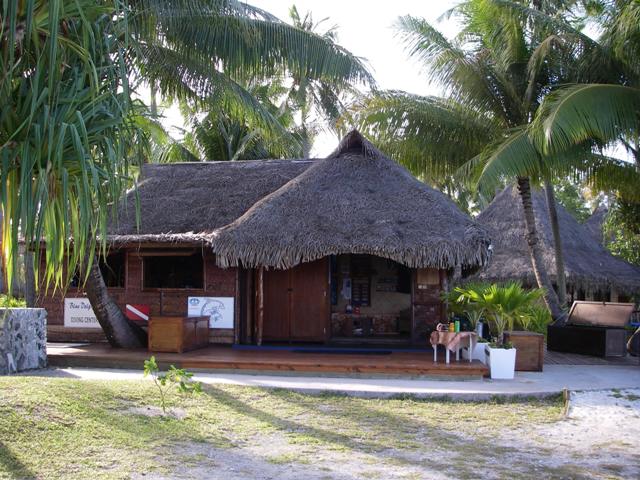
Members of the Food Chain in Tuamotu Islands June 27 2007
We have moved on from the Marquesas to the Tuamotu Islands. The Tuamotu Islands are a collection of 78 coral atolls spread across almost 1000 miles...first seen by Europeans in 1615. They are less lush than the Marquesas (consisting primarily of palm trees, pine trees and low grass...in addition to the ubiquitous hibiscus, bouganvilla and plumeria in a rainbow of colors) but equally striking in their own right with white coral beaches and multiple shades of turquoise blue waters. Historically, these islands were called the "Dangerous Archipelago" due to difficult visibility, seen at only 8 miles (due to low-lying topography), navigational risks presented by the coral reefs (difficult to spot and avoid except with bright sunlight) and challenging passes which are the sole gateway into the lagoon of each atoll (only to be attempted at slack tide in order to avoid the strong currents that can reach upwards of 10 knots). However, today (thanks to tide tables, charts and maps) they are a favorite cruising ground and a welcome stopover between the Marquesas and Tahiti. Scuba diving is at its most amazing with healthy reefs, colorful fish and many sharks...we were reminded of our place in the food chain after a dive below the surface. We decided to just make one stop in the Tuamotus...Rangiroa. The lagoon of Rangiroa is 45 miles long and 18 miles wide...a veritable inland sea.
Our successful early morning passage at slack tide through the Tiputa Pass and we were into the lagoon of Rangiroa (6/18)...rewarded by a solid anchor spot in 40 feet of water with a sandy bottom. No dawdling after five days passage on Barefeet...we hopped into Trouble and headed ashore. Chris got us signed up for a drift dive in the afternoon. As the drift dive was described in more detail Erin decided it was full of too many new elements so Chris went on without her (tomorrow we will do the reef dive together). According to Chris, it was really cool and a truly unique diving experience. The drift dive was at the pass to the atoll (the same one we motored through) where Chris and the other two divers and the two dive masters were dropped outside the pass to then drift along the bottom until they got into the lagoon where they were then picked up by the chase boat (dive company dinghy). As Chris described it...we started by dropping down to 90 feet below the surface. When you looked down you could see the outline of sharks...50, 70, maybe 100. They were hanging out on the actual bottom (below our 90 feet). But when they noticed us they drifted up in a huge spiral and swam around us. Then a school of 30 or so LARGE barracuda joined them...and we were like a bait ball with predators circling us. Never seen anything like it! And since we were in the water I wouldn't need to change my underwear when the dive was over (the current cleans everything). We then drifted into the pass - which was neat - but not as cool as all the sharks and barracudas. In the pass there were supposed to be dolphin jumping (we didn't see any) but we did see some 300 pound napoleon fish (or something that looked like it). The sharks and barracudas were not aggressive...just curious...so it was more of a curiosity ball than a bait ball - and to be fair - none of them were really that big. 3-4 footers, mostly. Holy cow - Erin was on the edge of her dry, palm shaded patch of grass during the re-telling!
After weeks without a restaurant we got dressed in our fancy duds (yes, even this is relative) and went to the hotel restaurant overlooking the lagoon...and started with a pina colada and a kir.
Anchored off of the Kia Ora hotel (www.hotelkiaora.com) is simplicity itself. The hotel dive shop (Blue Dolphin) conducted our dives, the hotel organized thrice per day trips to the pearl farm are open to cruisers, too, and bikes can be rented here. The bar and restaurant are a welcome indulgence and the grounds appear maintained by a Kuna coconut caretaker...immaculate! The reef dive (6/19) was wonderful...and just fine for Erin; clear water, healthy reef with lots of color and variation, schools of brightly colored fish, an eagle ray and a shark, too. We also managed to squeeze in a visit to the Gauguin Pearl Farm. The process of making a black pearl is a minimum of four years per pearl...a balance between human intervention and wonder of nature...efficiently run with nothing wasted and quality checks all along the way. For example, each technician responsible for grafting is given a color of rope on which grafted oysters are hung and "grown." This rope identifies him for his entire career...and clearly shows his skill (or lack there of) in creating pearls from the grafting once the pearls are finally harvested...definitely nowhere to hide sloppy work. We gained a better understanding of what makes a pearl unique and saw the variety of possibilities that are available. It is amazing that something as slimy and barnacled as the oyster can create such a lovely piece of jewelry...yes, we found something that we liked...a choker string of black pearls that will remind us of our visit to French Polynesia every time Erin puts them on...gosh are they beautiful!
Rangiroa has two villages; Avatoru and Tiputa. Since the wind has stayed strong (20-25 knots)...and we have stayed anchored...we have had a few days to explore and do some boat projects at a nice, slow pace. Biking into Avatoru allowed for stops along the way. There were pareos waving in the breeze, produce stands, small, one-room grocers (magasins) and general town center activities. Pareos are squares of cloth of various dimensions used as clothing; fashioned into loincloth/pants for men and skirts/dresses for women...no zippers or snaps just wrapped and knotted. They are colorful displays of flowers, landscapes and general aspects of everyday life. Village activity halts daily from 11:30am - 2pm when everything except restaurants (also called "snacks") close for lunch and a nap. The villages literally become ghost towns in which you could shoot a canon down "Main Street" and not hit a soul.
Tiputa is smaller than Avatoru but with similar commercial offerings. It is across the inlet and reached by water taxi. The water taxi driver is a friendly fellow who has added tattoos little by little year after year to his entire body. Although we have seen many men and women with various tattoos on backs, arms, legs and faces...he has combined them all...and is quite pleased to have his picture taken. Cars, mopeds and bicycles share the single paved road passing through each town without chaos or impatience. When renting a bicycle no lock was given and a basket made shopping easier. Life seems an ambling pace with the wind providing the strongest nudge to move along.
Off we went (6/24) for the overnight passage from the Tuamotu Islands to the Society Islands (approx 185 miles)...specifically Pape'ete, Tahiti. It was a familiar bumpy sea but we had wind this time (a bonus...kinda). It blew 20-25 knots with passing squalls up to 30 knots...maybe a bit more than we like but we really moved along. We scooted into the harbor and were thrilled with the lake calm anchorage with close proximity to the town of Pape'ete. We look forward to exploring the town and having access to all sorts of provisions...I think I may weep if I see tomatoes and lettuce.